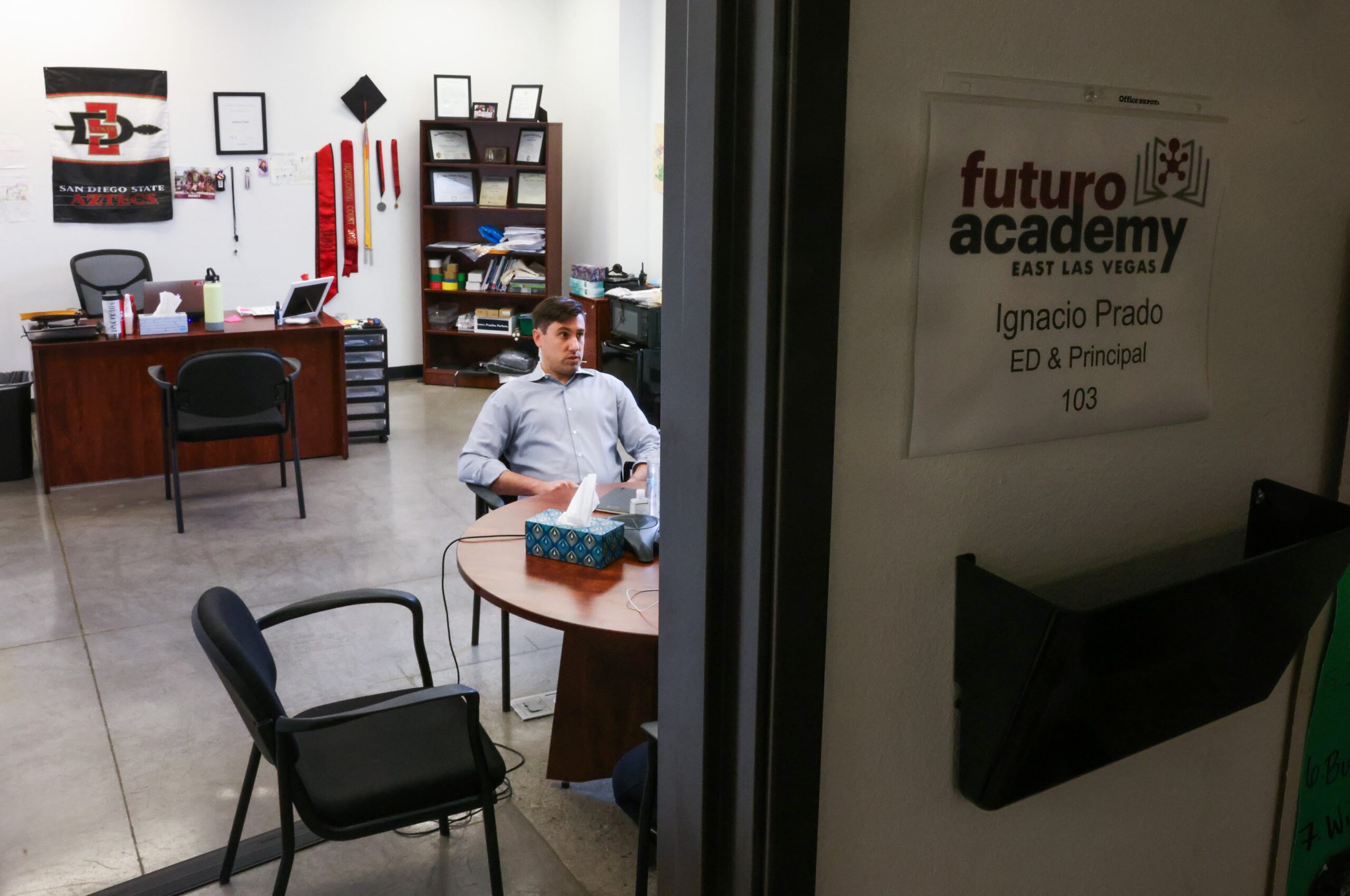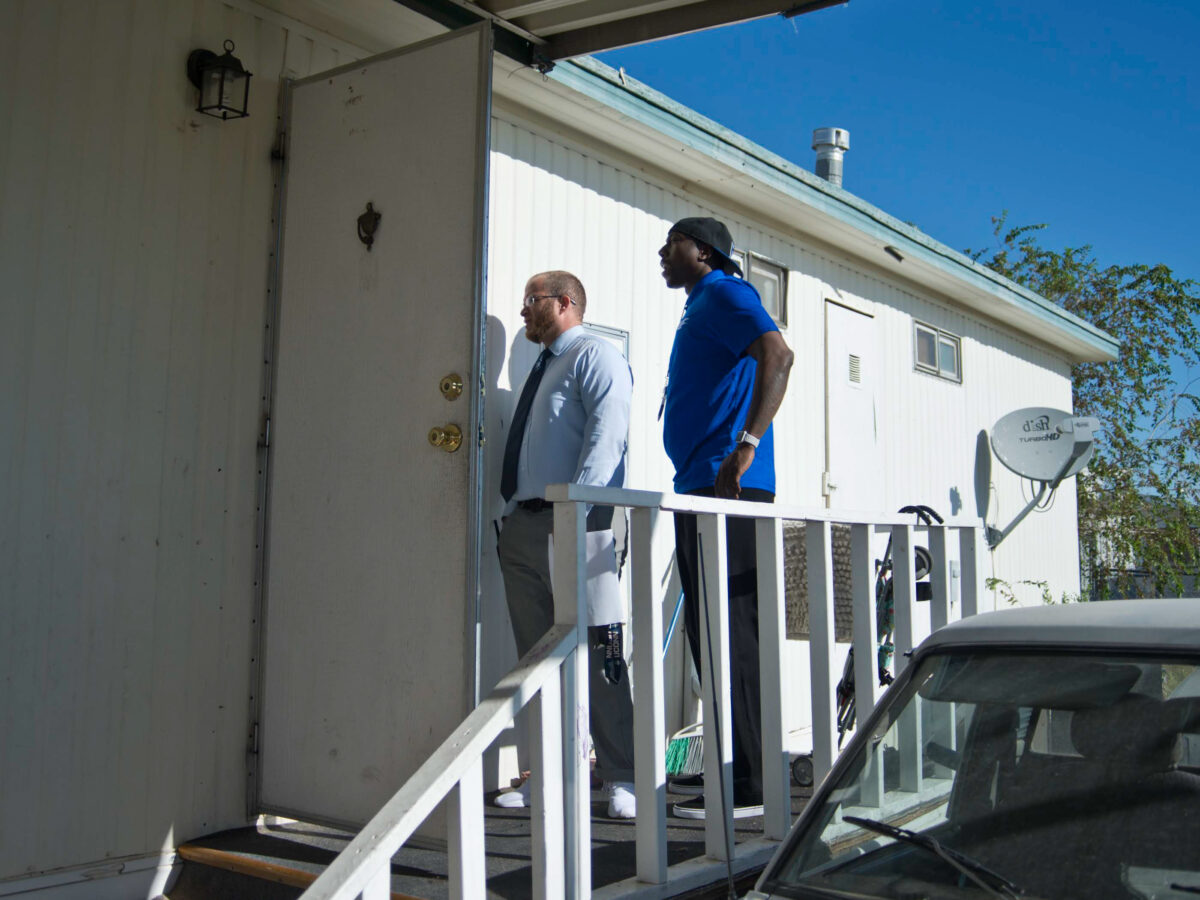More than a third of Nevada students chronically absent, continuing pandemic-era trend

Ignacio Prado has noticed a change at Futuro Academy in East Las Vegas ever since the pandemic: More parents are keeping their kids at home if they are sick.
It’s a factor that Prado, the K-5 charter school’s executive director, says is contributing to the school’s absenteeism rates, which decreased in the 2022-23 school year from the year before (from 57 percent to 38 percent) but remains much higher than before the pandemic (28 percent).
“When I have conferences with families, they just sort of say back to me a lot of what we said to them during the pandemic around not wanting to get other people sick,” he said. “Before the pandemic, coming to school with a cough wasn’t that big of a deal.”
The absenteeism rates at Futuro Academy mirror what’s happening statewide. Chronic absenteeism, which is when a student misses at least 10 percent of school days, decreased slightly in the 2022-23 school year in Nevada but remains significantly higher than before the pandemic, according to data released last month from the Nevada Department of Education (NDE). Nearly 35 percent of Nevada students were chronically absent in the 2022-23 school year. In the final year before the pandemic hit, around 19 percent of students were chronically absent.
While there are many reasons why a student may miss school, state education officials say the pandemic has spurred exponential rises in absenteeism rates. They’ve noticed greater health consciousness and emphasized how significant time away from in-person learning fostered a general decrease in student engagement that schools are still reeling from.
“It takes relatively little time for students to disengage,” said Christy McGill, the state’s deputy superintendent for educator effectiveness and family engagement. “But what we're learning is that it takes a longer amount of time to reengage.”
Chronic absenteeism covers all school absences, with exceptions for a positive coronavirus test and when a school district receives notice from a medical or mental health professional that a student is not fit to go to school. State data shows that students with high absenteeism rates in kindergarten and first grade are much less likely to be able to read by third grade. Absenteeism also is a key determinant of dropout rates.
There is no one way to curb chronic absenteeism, education officials said, but they added it is important to come up with strategies specific to each student’s circumstances and incentivize students to come to school, rather than discipline students for missing school.
Schools tend to use different approaches depending on the student, including home visits, attendance monitoring and engagement with the student’s parents. The state has also for years partnered with UNR to provide training to schools on an approach that moves away from using discipline to address absenteeism.
New efforts are also in the pipeline. The Clark County School District (CCSD) launched a program last month to curb absenteeism rates, and the state is looking at using Medicaid funds to bring in more mental health professionals in schools, McGill said.
“We don't have enough adults in our buildings,” McGill said. “Not only teachers, but school counselors, school [psychologists], school social workers and community health workers.”
Absenteeism soared after pandemic peaks
The 35 percent of Nevada students who were chronically absent last year was a 1 percentage point drop from the year before, but nearly double the rate (19 percent) from the final year before the pandemic.
Two-thirds of public schools reported drops in chronic absenteeism last school year. Of those schools, the average decrease was around 6 percentage points, according to a Nevada Independent analysis.
However, almost all schools still report absenteeism rates higher than they were before the pandemic. The average absenteeism change between the last school year and the 2018-2019 school year was an increase of 16 percentage points.
The chronic absenteeism rate for Black and Native American students was more than 10 percentage points higher than statewide averages, while Hispanic students also slightly outpaced absenteeism averages, according to the NDE data.
McGill, the NDE official, said the pandemic’s disproportionate effect on minority communities could have been a factor in the higher absenteeism rates for minority students.
CCSD schools, which have nearly two-thirds of the state’s students, reported an average of a roughly 16 percentage point increase in absenteeism since before the pandemic.
Washoe County schools saw a 5 percentage point increase in chronic absenteeism in the 2022-2023 school year from the year before, the second-biggest jump among all school districts. The district’s absenteeism rate is still lower than statewide averages but more than 20 percentage points higher than before the pandemic.
Doug Taylor, the county’s student attendance coordinator, said he was “concerned” about last year's increase. He also noted the rate may have increased because of a reporting change in how certain absences for coronavirus-related symptoms used to not count toward absenteeism rates. Those absences counted for the absenteeism rates last school year.
The state data follows nationwide trends.
The nonprofit organization Attendance Works estimates the number of chronically absent students nationwide may have grown to 16 million, more than double the figure from prior to the pandemic.
Attendance Works finds that the root causes behind chronic absenteeism fall into four categories: attendance barriers that include a lack of transportation, aversion to school such as unwelcoming school environments, general disengagement from school and misconceptions about the impact of absences.
“I know it's not something that we can resolve overnight,” said Attendance Works Executive Director Hedy Chang. “It's going to take multiple years of engagement and support.”
Peter Zutz, who oversees data and assessments within NDE, said that because the state saw general decreases in absenteeism last year, he’s optimistic the trend will continue.
“I'm very excited to see what that number is going to be [next year],” Zutz said.
How do schools address absenteeism?
The state’s primary way of addressing absenteeism is through the Multi-Tiered System of Supports Project at UNR, McGill said.
The project provides schools and districts with monthly training on how to best identify the causes of chronic absenteeism. The state education department is responsible for finding the funds for the program. The program outlines a list of interventions, ranging from offering a school refusal assessment and academic catch-up opportunities to monitoring the student’s attendance for 20 days and creating formal plans with families.
As of the 2020-2021 school year, 149 schools were part of the program. The absenteeism rate for participating schools was 3 percentage points lower that year than non-participating schools, according to a third-party program evaluation.
However, the project is not a quick fix. It first launched in 2015 and can take up to three years to be effective, McGill said.
There isn’t one short-term fix to chronic absenteeism, as approaches have different effectiveness levels depending on the student.
Kevin McPartlin, assistant superintendent of CCSD’s Education Services Division, said the district is taking a multifaceted approach across several departments to tackle the issue.
During the 2022-23 school year, CCSD had a chronic student absenteeism rate of 38 percent, slightly lower than the rate for the previous year, 40 percent. This year, attendance officers are making more than 500 home visits daily, about five times higher than last year.

In addition, McPartlin said the district is working on identifying and tracking students who are on the cusp of being considered chronically absent, and connecting those students with support services such as social workers.
“Those are the ones that are still in school where a social worker can reach out with the students, with the families, to try to avoid them reaching that plateau,” McPartlin said.
The district’s Family Engagement Office helps address obstacles keeping students from coming to school, such as lack of supplies, clothing and reliable transportation.
Last month, CCSD launched its Every Day Matters campaign, which emphasizes the importance of daily attendance through efforts such as daily notices to parents and guardians, data monitoring and collaboration with businesses, nonprofits and local governments.
The district has also begun a new individualized approach to the issue and is piloting a mentorship program at Von Tobel Middle School in East Las Vegas for students who are chronically absent or close to reaching that status. The mentors include a social worker and attendance officer who previously worked at the school and already has a connection with the school community.
Futuro Academy is having teachers do weekly check-ins with families if they don’t know why a student is absent. Prado said prior to the pandemic, those phone calls to students’ homes were largely made by office staff members.
“They’re just there to say, ‘Hey, what's going on?’” Prado said. “They're trying to just feel out if there's a challenge going on or some kind of crisis.”
Prado is looking to make even more progress on getting the school’s absenteeism rate down by offering transportation for students in the near future.
Like many charter schools, Futuro doesn’t receive dedicated transportation funding. But during the 2023 legislative session, lawmakers passed a bill pushed by Gov. Joe Lombardo that appropriated $7 million for charter school transportation for each of the next two fiscal years. In July, the State Public Charter School Authority’s board approved Futuro’s request for $216,000 of the funding.
According to the school’s application, Futuro estimates that between 15 to 40 percent of its students would benefit from centralized transportation that could help the school improve its on-time attendance rate and its average daily attendance.
Kimberly Crowley, the principal at Shaw Middle School in Washoe County, has seen a variety of reasons behind a student’s chronic absenteeism. Sometimes students don’t have enough transportation access. Other times, they are simply disinterested in coming to school.
Crowley said it is essential to build relationships with students and families. That way, families can reach out to school officials for help to get their kids to school, and knowing someone cares could incentivize students to come to school.
As an example, Crowley had a student who attended only about 40 percent of school days for the past couple of years. The school assigned a mentor to the student, which has helped improve the student’s attendance.
“That's the person that checks in on him every day,” she said. “And honestly, I think that did more for him than the punitive approach.”

